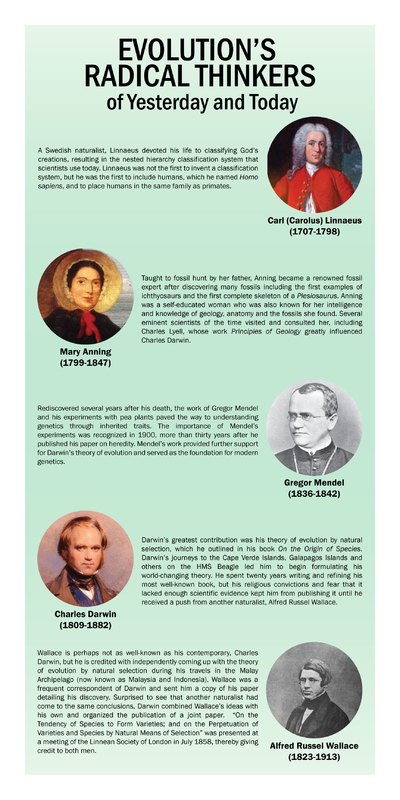Evolution's Radical Thinkers 1
Carl (Carolus) Linnaeus (1707-1798)
A Swedish naturalist, Linnaeus devoted his life to classifying God’s creations, resulting in the nested hierarchy classification system that scientists use today. Linnaeus was not the first to invent a classification system, but he was the first to include humans, which he named Homo sapiens, and to place humans in the same family as primates.
Mary Anning (1799-1847)
Taught to fossil hunt by her father, Anning became a renowned fossil expert after discovering many fossils including the first examples of ichthyosaurs and the first complete skeleton of a Plesiosaurus. Anning was a self-educated woman who was also known for her intelligence and knowledge of geology, anatomy and the fossils she found. Several eminent scientists of the time visited and consulted her, including Charles Lyell, whose work Principles of Geology greatly influenced Charles Darwin.
Gregor Mendel (1822-1884)
Rediscovered several years after his death, the work of Gregor Mendel and his experiments with pea plants paved the way to understanding genetics through inherited traits. The importance of Mendel’s experiments was recognized in 1900, more than thirty years after he published his paper on heredity. Mendel’s work provided further support for Darwin’s theory of evolution and served as the foundation for modern genetics.
Charles Darwin (1809-1882)
Darwin’s greatest contribution was his theory of evolution by natural selection, which he outlined in his book On the Origin of Species. Darwin’s journeys to the Cape Verde Islands, Galapagos Islands and others on the HMS Beagle led him to begin formulating his world-changing theory. He spent twenty years writing and refining his most well-known book, but his religious convictions and fear that it lacked enough scientific evidence kept him from publishing it until he received a push from another naturalist, Alfred Russel Wallace.
Alfred Russel Wallace (1823-1913)
Wallace is perhaps not as well-known as his contemporary, Charles Darwin, but he is credited with independently coming up with the theory of evolution by natural selection during his travels in the Malay Archipelago (now known as Malaysia and Indonesia). Wallace was a frequent correspondent of Darwin and sent him a copy of his paper detailing his discovery. Surprised to see that another naturalist had come to the same conclusions, Darwin combined Wallace’s ideas with his own and organized the publication of a joint paper. “On the Tendency of Species to Form Varieties; and on the Perpetuation of Varieties and Species by Natural Means of Selection” was presented at a meeting of the Linnean Society of London in July 1858, thereby giving credit to both men.
